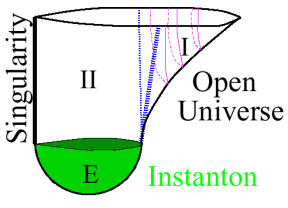InstantonsHawking and I made progress with the Hartle-Hawking proposal when we
realised there is a simple class of classical solutions to the field equations
for gravity coupled to an inflationary scalar field, which yield a finite
probability according to the Dirac-Feynman formula in imaginary time.
Figure 3: An infinite open Universe emerges from a ‘pea’ instanton. Region I is an infinite inflating open ‘island Universe’. Region II an approximately de Sitter region Φ is nearly constant) bounded by a time-like singularity. There are actually a one parameter family of finite probability solutions, in which we have a one-to-one relation
where Ω0 is the current density parameter, and Φ0 is the value of the scalar field at the regular pole of the instanton. For the solutions described above, Ωo < 1, but if one allows instantons which are singular at both poles, and symmetric about the maximum of b, these analytically continue to closed inflating Universes, and one can obtain any value of Ωo > 1. The classical instanton solutions could then be used to compute the
quantum fluctuations about inflating spacetimes in a more precise manner than
had hitherto been possible. In
particular, previous calculations had to make more or less ad hoc choices for
the initial quantum state. But in these new solutions the initial quantum state
was initially and precisely defined from the no boundary proposal.
Contributed by: Dr. Neil Turok |
|
Source: Neil Turok Related Media:
Other Resources:
|






